Class 12 : Biology (English) – Lesson 1 Sexual Reproduction in Flowering Plants
EXPLANATION & SUMMARY
🌼 Introduction
Flowering plants (angiosperms) reproduce sexually through a complex, coordinated process that ensures genetic variation and survival of the species. This chapter explores how male and female gametes are formed, how pollination and fertilisation occur, and how fruits and seeds are developed. It also introduces processes like apomixis and parthenocarpy.
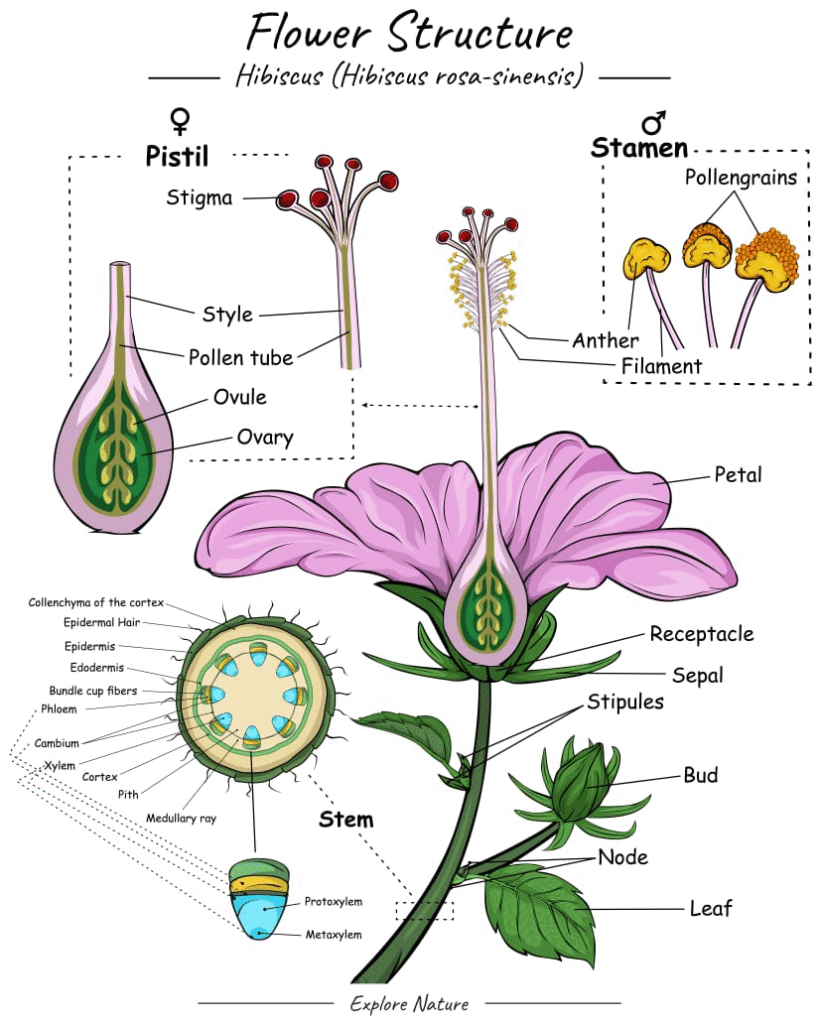
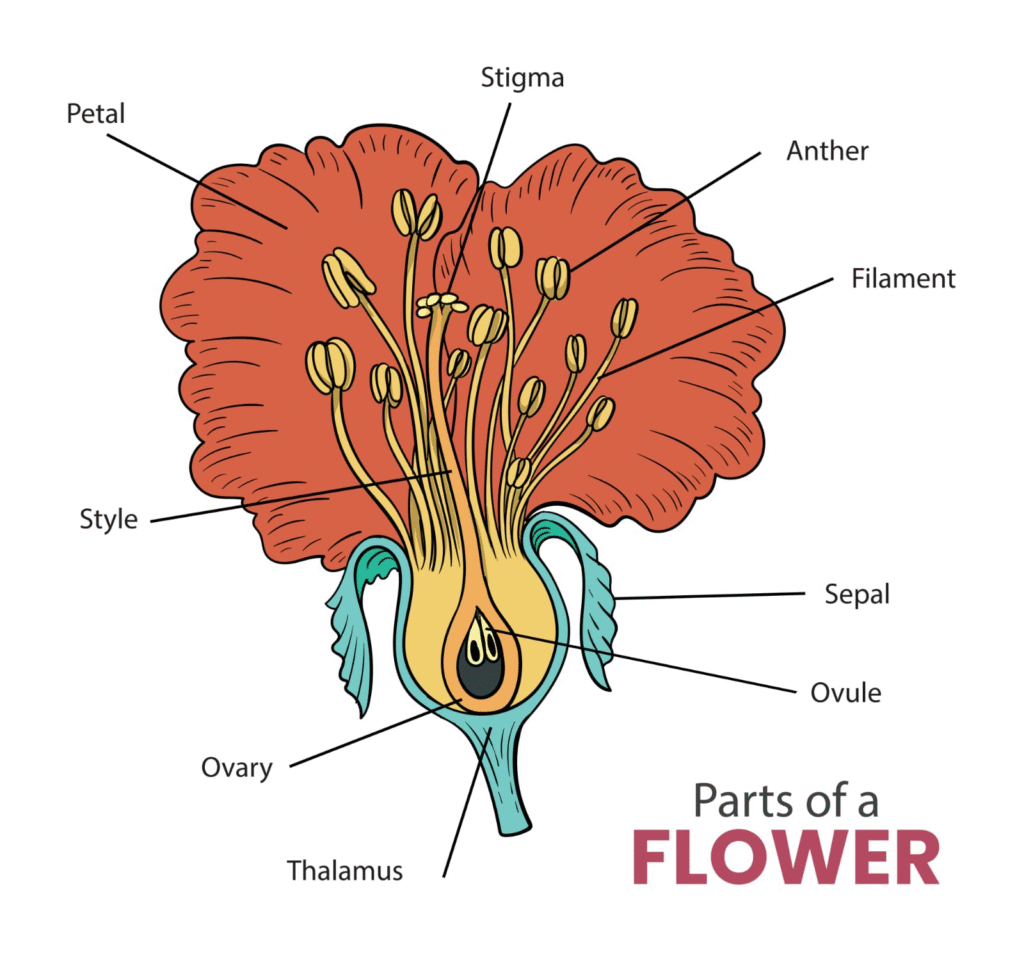
🌱 1. Flower – A Reproductive Unit
The flower is the site of sexual reproduction in angiosperms. A typical flower has four concentric whorls:
Calyx (sepals) – protection
Corolla (petals) – attraction
Androecium (stamens) – male reproductive part
Gynoecium (carpels) – female reproductive part
♂️ 2. Development of Male Gametophyte
🧬 2.1 Structure of Stamen
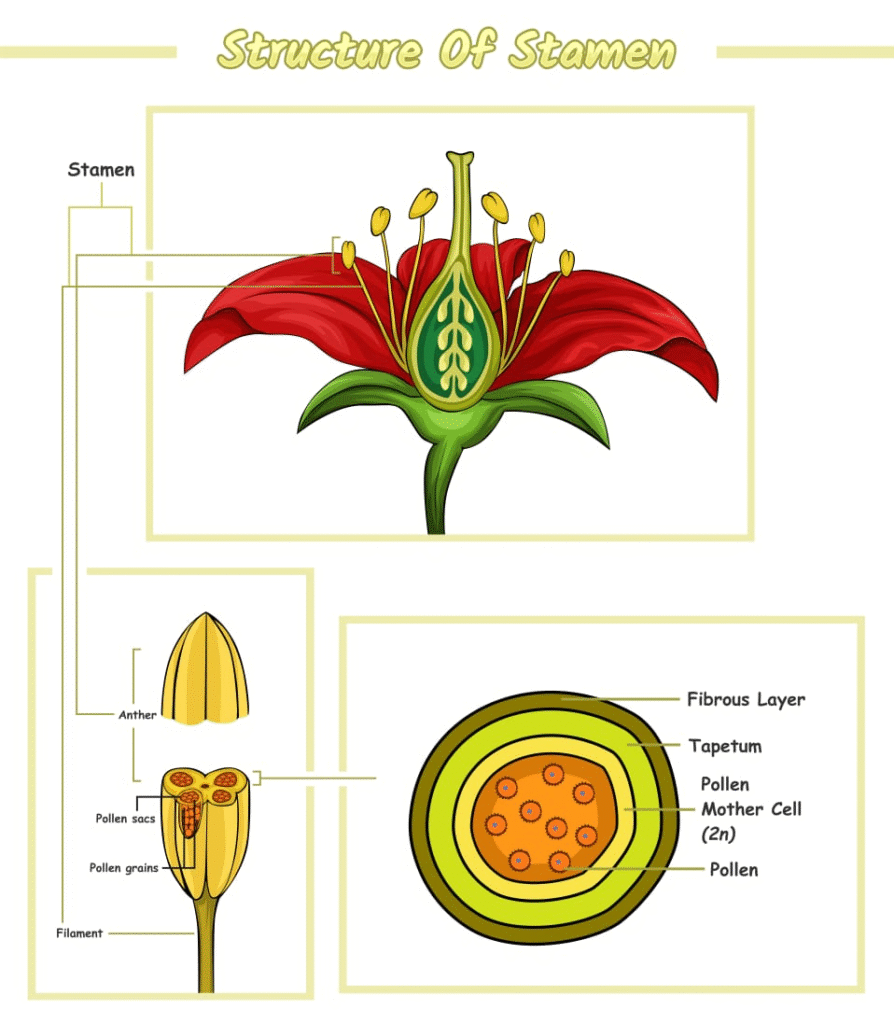
A stamen consists of a filament and an anther. The anther is bilobed and each lobe contains two pollen sacs. A typical anther is tetrasporangiate.
🔍 2.2 Microsporogenesis
Microsporogenesis is the process by which pollen mother cells (PMCs) undergo meiosis to form haploid microspores.
These microspores remain together temporarily in a tetrad.
Each microspore develops into a pollen grain, the male gametophyte.
🧪 2.3 Pollen Grain Structure
Pollen grains are surrounded by a two-layered wall:
Exine: tough, made of sporopollenin (chemically inert)
Intine: inner cellulose and pectin wall
Mature pollen contains:
Vegetative cell (large)
Generative cell (small) → divides into two male gametes
♀️ 3. Development of Female Gametophyte
🌸 3.1 Structure of Ovule
The ovule is attached to the placenta by a funicle.
It has one or two integuments with a micropyle at one end.
The central mass, nucellus, contains the embryo sac (female gametophyte).
🔁 3.2 Megasporogenesis
The megaspore mother cell (MMC) inside the nucellus undergoes meiosis forming four megaspores, only one of which survives.
This functional megaspore develops into the embryo sac.
🔍 3.3 Structure of Embryo Sac
The typical embryo sac is 7-celled and 8-nucleate:
3 cells at micropylar end: one egg cell + 2 synergids
2 polar nuclei in central cell
3 antipodal cells at chalazal end
Monosporic development: only one megaspore forms the gametophyte.
🍃 4. Pollination
Pollination is the transfer of pollen from anther to stigma. It is of three types:
Autogamy – same flower
Geitonogamy – different flowers of same plant
Xenogamy – flowers of different plants
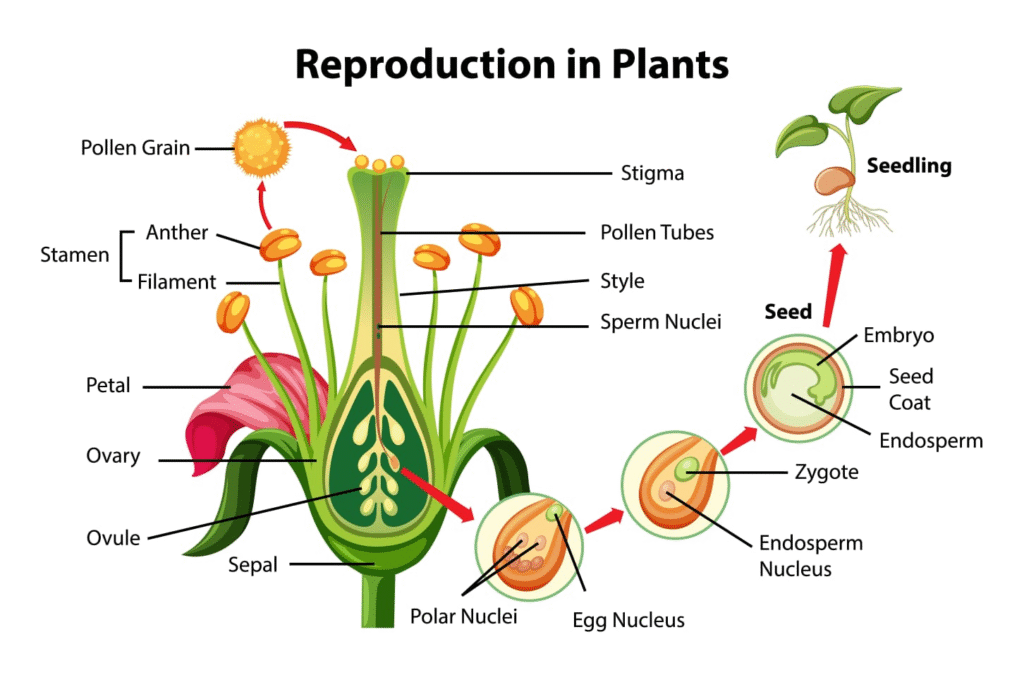
💡 4.1 Chasmogamy and Cleistogamy
Chasmogamous flowers: open flowers
Cleistogamous flowers: closed flowers – ensure autogamy
🔄 4.2 Agents of Pollination
Abiotic agents: wind (anemophily), water (hydrophily)
Biotic agents: insects, birds, bats
🚫 4.3 Outbreeding Devices
Plants avoid self-pollination through:
Herkogamy (physical barrier)
Dichogamy (different timing of maturity)
Self-incompatibility (genetic mechanism)
Male and female flowers on different plants (dioecy)
🧪 5. Pollen-Pistil Interaction
The interaction between the pollen grain and stigma determines compatibility.
In compatible pollen, the pollen tube grows through the style, guided by chemical cues, and enters the ovule through the micropyle.
🌟 6. Double Fertilisation
A unique feature of angiosperms is double fertilisation:
One male gamete fuses with egg → zygote (syngamy)
Other gamete fuses with polar nuclei → triploid endosperm nucleus (triple fusion)
Thus:
Syngamy + Triple fusion = Double fertilisation
🍼 7. Post-Fertilisation Events
After fertilisation, the following changes occur:
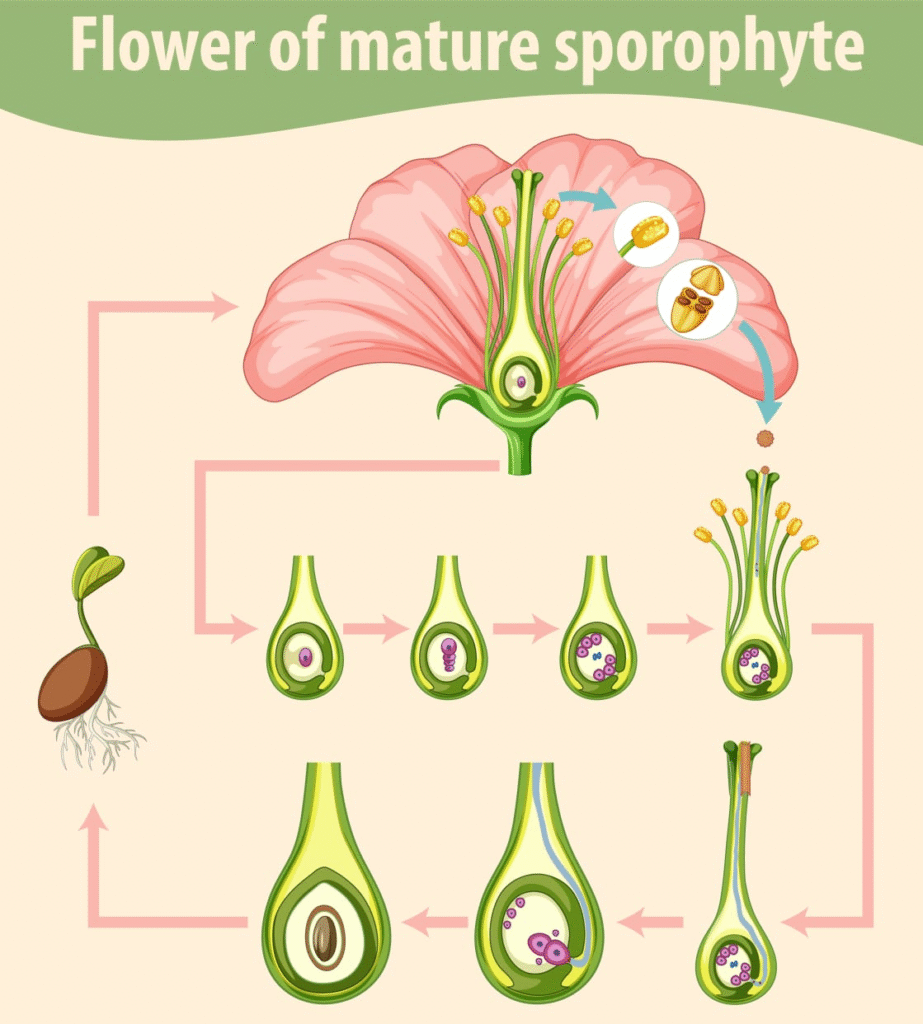
🌿 7.1 Endosperm Development
Endosperm provides nourishment to the embryo.
Formed before the embryo.
Types:
Nuclear – free nuclear divisions (most common)
Cellular – wall formation after each division
Helobial – intermediate
🌱 7.2 Embryo Development
Zygote divides to form embryo with:
Radicle (root tip)
Plumule (shoot tip)
Cotyledons
Hypocotyl and epicotyl
Monocot embryos (like maize) have one cotyledon and structures like scutellum, coleoptile, and coleorhiza.
🌰 8. Seed and Fruit Formation
Ovules → seeds
Ovary → fruit
Integuments → seed coat (testa and tegmen)
🍎 8.1 True and False Fruits
True fruit: formed from ovary only
False fruit: formed from ovary + other floral parts (e.g., apple – thalamus)
🌾 9. Special Modes of Reproduction
🧬 9.1 Apomixis
Seeds formed without fertilisation.
Common in grasses.
Ensures clonal propagation and maintains hybrid vigour.
🍌 9.2 Parthenocarpy
Development of seedless fruit without fertilisation (e.g., banana).
Can be induced by applying growth hormones.
🧬 10. Significance of Sexual Reproduction
Introduces genetic variation
Ensures adaptation and evolution
Maintains genetic lineage
Important for plant breeding, agriculture, and biodiversity
✍️ SUMMARY (Approx. 300 Words)
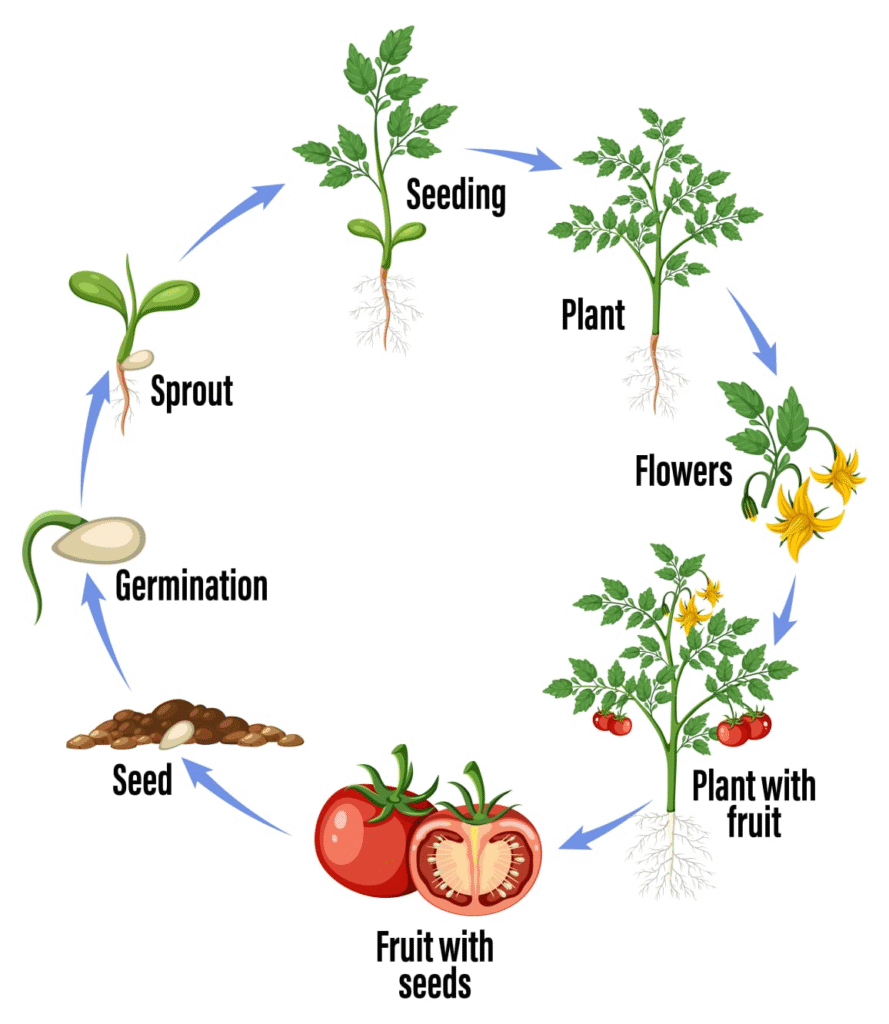
The flower is the reproductive unit of angiosperms, consisting of stamens (male) and carpels (female).
Microsporogenesis forms microspores from pollen mother cells via meiosis, developing into pollen grains.
Each pollen grain contains a vegetative and generative cell, the latter producing two male gametes.
Megasporogenesis occurs inside the ovule, where one megaspore from a tetrad survives and forms the embryo sac. The mature female gametophyte is 7-celled and 8-nucleate.
Pollination is the transfer of pollen to stigma, with autogamy, geitonogamy, and xenogamy as types. Self-pollination is avoided by mechanisms like herkogamy, dichogamy, and self-incompatibility.
Pollen-pistil interaction ensures compatibility. The pollen tube guides male gametes to the embryo sac via the micropyle.
Double fertilisation is a unique angiosperm process where:
One sperm fertilises the egg (forms zygote)
Another fuses with polar nuclei (forms endosperm)
Post-fertilisation events include:
Zygote forming embryo (radicle, plumule, cotyledons)
Endosperm development for embryo nourishment
Ovule converting into seed, ovary into fruit
Seeds may be formed without fertilisation in apomixis, and parthenocarpy leads to seedless fruits, useful in horticulture.
Sexual reproduction introduces variation, supports evolution, and enhances adaptation. It is critical for maintaining diversity and is harnessed in plant breeding programs for crop improvement.
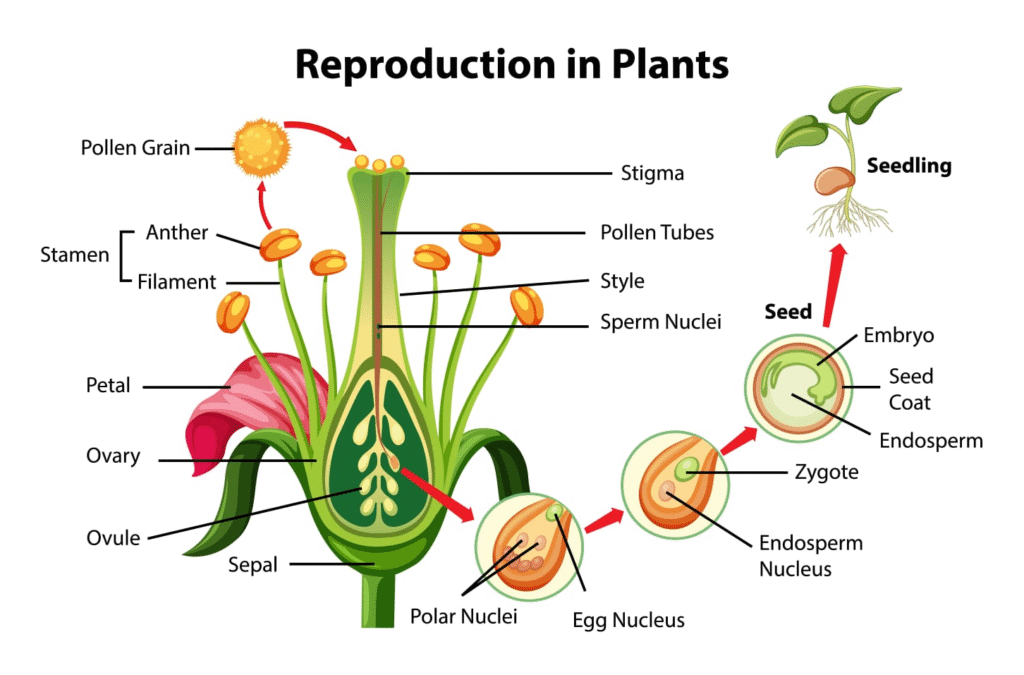
————————————————————————————————————————————————————————————————————————————
QUESTIONS FROM TEXTBOOK
Q1. Name the parts of an angiosperm flower in which development of male and female gametophyte take place.
Answer:
Male gametophyte development takes place in the anther (part of the stamen).
Female gametophyte development takes place in the ovule (located inside the ovary of the pistil).
Q2. Differentiate between microsporogenesis and megasporogenesis. Which type of cell division occurs during these events? Name the structures formed at the end of these two events.
Answer:
Feature Microsporogenesis Megasporogenesis
Occurs in Anther Ovule
Starting cell Microspore mother cell (MMC) Megaspore mother cell (MMC)
End products Microspore tetrad (4 haploid microspores) One functional megaspore (3 degenerate)
Cell division type Meiosis Meiosis
Gametophyte formed Male gametophyte (pollen grain) Female gametophyte (embryo sac)
Type of division: Both involve meiosis.
Final structure formed:
Microsporogenesis → Microspore (male gametophyte precursor)
Megasporogenesis → Functional megaspore (female gametophyte precursor)
Q3. Arrange the following terms in the correct developmental sequence:
Pollen grain, sporogenous tissue, microspore tetrad, pollen mother cell, male gametes
Answer:
Correct sequence:
Sporogenous tissue → Pollen mother cell → Microspore tetrad → Pollen grain → Male gametes
Q4. With a neat, labelled diagram, describe the parts of a typical angiosperm ovule.

Answer:
Description:
A typical ovule is also called megasporangium. It is composed of the following parts:
Funicle – stalk that attaches ovule to the placenta.
Hilum – junction between the ovule and funicle.
Integuments – protective layers surrounding the ovule (usually two).
Micropyle – small opening at the tip of the ovule where pollen tube enters.
Nucellus – central mass of parenchymatous cells, provides nutrition.
Embryo sac – female gametophyte formed inside the nucellus.
Diagram: (Textual format)
Micropyle
↓
/ \
Integuments |
/ \ |
| |← Nucellus (with embryo sac)
___/ |
__________/
↑
Chalaza
|
Funicle
Q5. What is meant by monosporic development of female gametophyte?
Answer:
Monosporic development refers to the formation of the female gametophyte (embryo sac) from a single functional megaspore out of the four megaspores produced by meiosis of the megaspore mother cell.
The other three megaspores degenerate.
The remaining megaspore undergoes three mitotic divisions to form the 8-nucleate, 7-celled embryo sac.
Q6. With a neat diagram explain the 7-celled, 8-nucleate nature of the female gametophyte.

Answer:
Explanation:
The functional megaspore undergoes three mitotic divisions:
First division → 2 nuclei
Second division → 4 nuclei
Third division → 8 nuclei
These nuclei are arranged as follows:
3 at micropylar end → 1 egg cell + 2 synergids (1 cell each)
3 at chalazal end → 3 antipodal cells
2 in center → polar nuclei (remain in a single central cell)
Thus, 8 nuclei are distributed in 7 cells:
1 egg cell
2 synergids
3 antipodals
1 central cell with 2 nuclei
Diagram: (Textual format)
Chalazal end
| Antipodals (3) |
| |
| Central Cell | ← 2 Polar Nuclei
| |
| Synergids (2) |
| Egg Cell (1) | ← Micropylar end
Q7. What are chasmogamous flowers? Can cross-pollination occur in cleistogamous flowers? Give reasons for your answer.
Answer:
Chasmogamous flowers are flowers which open at maturity and expose their reproductive organs (anthers and stigma) for pollination.
Cleistogamous flowers are flowers that never open. Since the stigma and anthers are enclosed together, only self-pollination occurs in them.
Can cross-pollination occur in cleistogamous flowers?
No, because the flowers remain closed, the entry of pollen from other flowers is not possible.
Hence, cross-pollination does not occur in cleistogamous flowers; only autogamy (self-pollination) takes place.
Q8. Mention two strategies evolved to prevent self-pollination in flowers.
Answer:
Two strategies to prevent self-pollination are:
Herkogamy:
Structural barrier between anthers and stigma of the same flower (e.g., stigma is at a higher position than anthers).
Prevents physical contact between pollen and stigma.
Example: Hibiscus.
Dichogamy:
Maturation of anther and stigma at different times.
Two types:
Protandry: Anthers mature before stigma (e.g., Sunflower)
Protogyny: Stigma matures before anthers (e.g., Datura)
Q9. What is self-incompatibility? Why does self-pollination not lead to seed formation in self-incompatible species?
Answer:
Self-incompatibility is a genetic mechanism in flowering plants that prevents self-pollen from fertilizing the ovule.
It prevents inbreeding and promotes genetic diversity.
Reason for failure of seed formation:
In self-incompatible species, the pollen grain fails to germinate on the stigma or the pollen tube is blocked.
Therefore, even though pollen from the same plant lands on the stigma, fertilization doesn’t occur, and seeds are not formed.
Q10. What is bagging technique? How is it useful in a plant breeding programme?
Answer:
Bagging is the process of covering the flower with a butter paper or polythene bag to prevent unwanted pollination.
This is done before anthesis (opening of the flower).
Use in plant breeding:
It ensures that the stigma receives pollen only from desired parent plants.
After bagging, controlled pollination is done by introducing selected pollen, ensuring hybrid formation.
Q11. What is triple fusion? Where and how does it take place? Name the nuclei involved in triple fusion.
Answer:
Triple fusion is the process in which one male gamete fuses with the two polar nuclei present in the central cell of the embryo sac.
It occurs in the central cell of the embryo sac during fertilization.
Process:
Pollen tube releases two male gametes into the embryo sac.
One gamete fuses with egg → syngamy → zygote
Other gamete fuses with two polar nuclei → triple fusion → primary endosperm nucleus (PEN)
Nuclei involved:
One male gamete nucleus
Two polar nuclei of the central cell
Q12. Why do you think the zygote is dormant for sometime in a fertilised ovule?
Answer:
The zygote remains dormant until the endosperm is formed because:
Endosperm serves as the nutritive tissue for the developing embryo.
Development of embryo (from zygote) requires a ready supply of nutrients.
Conclusion:
Dormancy ensures that the zygote does not start division until the endosperm (which forms earlier via triple fusion) is developed and available.
Q13. Differentiate between:
(a) Hypocotyl and epicotyl
(b) Coleoptile and coleorrhiza
(c) Integument and testa
(d) Perisperm and pericarp
Answer:
Feature First Term Second Term
(a) Hypocotyl Part of embryo below cotyledons; forms root Part of embryo above cotyledons; forms shoot
(b) Coleoptile Protective sheath covering plumule in monocots Protective sheath covering radicle in monocots
(c) Integument Protective layer(s) of ovule Seed coat developed from integuments
(d) Perisperm Remnant of nucellus in some seeds; may store food Wall of ovary that develops into fruit wall
Q14. Why is apple called a false fruit? Which part(s) of the flower forms the fruit?
Answer:
Apple is called a false fruit because it is formed from the thalamus, not just the ovary.
In false fruits, parts other than the ovary also contribute to fruit formation.
In apple, the thalamus becomes fleshy and forms the edible part of the fruit.
Q15. What is meant by emasculation? When and why does a plant breeder employ this technique?
Answer:
Emasculation is the removal of anthers from a bisexual flower before they mature.
This prevents self-pollination and ensures controlled cross-pollination.
Used when:
The flower is bisexual (has both male and female parts).
Plant breeders want to cross-pollinate the flower using desired pollen from another plant.
Q16. If one can induce parthenocarpy through the application of growth substances, which fruits would you select to induce parthenocarpy and why?
Answer:
Fruits such as banana, grapes, watermelon, and orange are selected for induced parthenocarpy.
Why:
These fruits have high consumer demand in seedless form.
Seedless varieties improve edibility and market value.
Q17. Explain the role of tapetum in the formation of pollen-grain wall.
Answer:
Tapetum is the innermost layer of the anther wall, surrounding the sporogenous tissue.
It is nutritive and secretes materials essential for pollen development.
Role in pollen wall formation:
Tapetum secretes sporopollenin precursors, which form the exine layer (outer tough wall) of pollen grain.
It also helps in the formation of pollen coat, enzymes, and proteins important for pollen viability.
Q18. What is apomixis and what is its importance?
Answer:
Apomixis is a form of asexual reproduction that mimics sexual reproduction but does not involve fertilization.
Seeds are formed without fusion of gametes.
Importance:
Produces genetically identical offspring (clones).
Maintains hybrid vigour in successive generations.
Useful in agriculture and horticulture to produce uniform high-yielding crops.
————————————————————————————————————————————————————————————————————————————
OTHER IMPORTANT QUESTIONS FOR EXAMS
(CBSE MODEL QUESTIONS PAPER)
ESPECIALLY MADE FROM THIS LESSON ONLY
Q1. In a typical angiosperm, male gametophyte is represented by:
(A) Microspore mother cell
(B) Pollen grain
(C) Anther
(D) Generative cell
Answer: (B) Pollen grain
Q2. Which one of the following is the outermost layer in a mature anther?
(A) Endothecium
(B) Tapetum
(C) Epidermis
(D) Middle layer
Answer: (C) Epidermis
Q3. The term ‘double fertilisation’ refers to:
(A) Fertilisation involving two ovules
(B) Fusion of two male gametes
(C) Two fertilisation events in the same embryo sac
(D) Fusion of one male gamete with antipodals
Answer: (C) Two fertilisation events in the same embryo sac
Q4. Pollen viability refers to:
(A) The capacity of pollen to stick to stigma
(B) The ability of pollen to germinate
(C) The ability of pollen to cause self-incompatibility
(D) The number of nuclei in pollen
Answer: (B) The ability of pollen to germinate
Q5. Assertion (A): Cleistogamous flowers show guaranteed self-pollination.
Reason (R): Their anthers and stigma are exposed to air.
(A) Both A and R are true, and R is the correct explanation of A
(B) Both A and R are true, but R is not the correct explanation of A
(C) A is true, R is false
(D) A is false, R is true
Answer: (C) A is true, R is false
Q6. The exine of a pollen grain is made of:
(A) Lignin
(B) Cellulose
(C) Cutin
(D) Sporopollenin
Answer: (D) Sporopollenin
Q7. The function of the tapetum in the anther is to:
(A) Protect the pollen sac
(B) Provide nutrition to developing microspores
(C) Form the filament
(D) Develop into pollen grains
Answer: (B) Provide nutrition to developing microspores
Q8. Which structure in a flower is responsible for the formation of the seed coat?
(A) Endosperm
(B) Nucellus
(C) Integuments
(D) Funicle
Answer: (C) Integuments
Q9. In which type of endosperm development does free nuclear division occur?
(A) Nuclear
(B) Cellular
(C) Helobial
(D) Syncytial
Answer: (A) Nuclear
Q10. Arrange the following in the correct order of embryo sac development:
Functional megaspore
Megaspore mother cell
Embryo sac
Megaspore tetrad
(A) 2 → 4 → 1 → 3
(B) 2 → 1 → 4 → 3
(C) 1 → 2 → 3 → 4
(D) 3 → 2 → 1 → 4
Answer: (A) 2 → 4 → 1 → 3
Q11. Very short answer:
What is the role of synergids in the embryo sac?
Answer:
Synergids help guide the pollen tube into the embryo sac by secreting chemical attractants.
Q12. Very short answer:
Name the three components of a mature embryo sac at the micropylar end.
Answer:
One egg cell and two synergids.
Q13. Very short answer:
Which part of the ovule becomes the seed after fertilisation?
Answer:
The ovule itself becomes the seed.
Q14. Very short answer:
Define emasculation.
Answer:
Emasculation is the removal of anthers from a bisexual flower to prevent self-pollination.
Q15. Case-based MCQ:
Read the following passage and answer the question:
“In some plants, both male and female reproductive organs mature at different times in a flower to prevent self-pollination.”
Which of the following terms describes this condition?
(A) Herkogamy
(B) Dichogamy
(C) Cleistogamy
(D) Apomixis
Answer: (B) Dichogamy
Q16. Case-based MCQ:
“In grass species, seeds are formed without fertilisation and produce progeny genetically identical to the parent.”
This type of reproduction is:
(A) Parthenogenesis
(B) Polyembryony
(C) Apomixis
(D) Cleistogamy
Answer: (C) Apomixis
Q17. Assertion (A): Polar nuclei participate in triple fusion.
Reason (R): They fuse with a male gamete to form a diploid nucleus.
(A) Both A and R are true, and R is the correct explanation of A
(B) Both A and R are true, but R is not the correct explanation of A
(C) A is true, R is false
(D) A is false, R is true
Answer: (C) A is true, R is false
Q18. MCQ:
Which plant hormone is commonly used to induce parthenocarpy in fruits?
(A) Cytokinin
(B) Ethylene
(C) Auxin
(D) Gibberellin
Answer: (D) Gibberellin
Q19. Define geitonogamy. How is it both similar to and different from autogamy?
Answer:
Geitonogamy is the transfer of pollen grains from the anther of one flower to the stigma of another flower on the same plant.
Similarity to autogamy: Both involve pollen from the same genetic individual.
Difference: Geitonogamy requires a pollinating agent, while autogamy is within the same flower and often doesn’t.
Q20. Why is sporopollenin considered the most resistant biological material? Mention one significance of this property.
Answer:
Sporopollenin is highly resistant to physical and biological decomposition due to its stable chemical structure.
Significance: It ensures the preservation of pollen grains for a long time in fossil records, helping in palynology.
Q21. Explain the role of synergids in the fertilisation process in flowering plants.
Answer:
Synergids secrete chemical attractants (like LURE peptides) that guide the pollen tube into the embryo sac.
One of the synergids degenerates to facilitate entry of the pollen tube and release of male gametes.
Q22. Why are cleistogamous flowers considered highly adapted for ensuring seed formation? Give one advantage and one disadvantage.
Answer:
Advantage: Guaranteed self-pollination even in absence of pollinators, ensuring reproductive success.
Disadvantage: No genetic variation occurs, which can make plants vulnerable to diseases or environmental changes.
Q23. Distinguish between perisperm and endosperm. Mention one example where each is found.
Answer:
Perisperm: Remnant of nucellus in seed; e.g., black pepper.
Endosperm: Triploid tissue formed after fertilisation, stores nutrients; e.g., wheat.
Q24. Describe the development of a pollen grain from a microspore mother cell.
Answer:
Step 1: Microspore mother cell undergoes meiosis → forms microspore tetrad (4 haploid cells).
Step 2: Each microspore separates and develops a thick wall – exine and intine.
Step 3: The microspore nucleus divides mitotically to form two cells:
A large vegetative cell
A small generative cell
This forms the mature male gametophyte (pollen grain).
Q25. What is emasculation? In which type of flowers is it done, and why?
Answer:
Emasculation is the removal of anthers from bisexual flowers before they dehisce.
Done in: Bisexual flowers.
Purpose: To prevent self-pollination during hybridisation, allowing only desired pollen from another plant to fertilise the flower.
Q26. Explain the process of triple fusion in angiosperms. Why is it termed as such?
Answer:
One male gamete fuses with two polar nuclei in the central cell of the embryo sac.
This results in the formation of a triploid primary endosperm nucleus.
Called triple fusion because three haploid nuclei (2 polar + 1 male) fuse.
It is part of the double fertilisation event unique to angiosperms.
Q27. Differentiate between autogamy, geitonogamy, and xenogamy with one example each.
Answer:
Type Description Example
Autogamy Pollen transfer within the same flower Pea
Geitonogamy Pollen transfer between flowers of same plant Maize
Xenogamy Pollen transfer between different plants Apple
Q28. Describe the development of a female gametophyte (embryo sac) in a monosporic ovule.
Answer:
A megaspore mother cell undergoes meiosis to form a linear tetrad of four haploid megaspores.
Only one functional megaspore (usually the chalazal one) survives; others degenerate.
This megaspore undergoes three mitotic divisions to form 8 nuclei.
These arrange into seven cells:
1 egg cell, 2 synergids at micropylar end
3 antipodals at chalazal end
1 central cell with 2 polar nuclei
→ This forms the 7-celled, 8-nucleate embryo sac.
Q29. Read the passage below and answer the following:
Pollen grains are essential for plant reproduction. They need to be viable for successful fertilisation. Pollen grains are preserved for years in pollen banks, helping in crop improvement and hybridisation.
(a) What is pollen viability and how long can it be retained under natural conditions?
(b) Name two factors that affect pollen viability.
(c) Why are pollen banks important in modern agriculture?
(d) Which two crops have pollen grains that remain viable for months?
Answer:
(a) Pollen viability refers to the ability of pollen to germinate and effect fertilisation. Under natural conditions, viability ranges from a few minutes to months depending on species.
(b) Factors affecting viability:
Temperature
Humidity
(c) Pollen banks store viable pollen for years, enabling cross-breeding across seasons and conserving rare germplasm.
(d) Rye and tomato are known to have pollen grains that remain viable for several months.
Q30. Read the passage below and answer the following:
Double fertilisation is a unique feature of angiosperms where two fertilisation events occur inside the same embryo sac.
(a) Name the two products of double fertilisation.
(b) Which cells or nuclei participate in these two events?
(c) Write the ploidy of zygote and endosperm.
(d) Explain why the endosperm develops before the embryo.
Answer:
(a) Zygote and primary endosperm nucleus.
(b)
Zygote: Egg cell + one male gamete
Endosperm: Two polar nuclei + other male gamete
(c)
Zygote: Diploid (2n)
Endosperm: Triploid (3n)
(d) Endosperm forms first to nourish the developing embryo; it serves as a source of nutrition.
Q31. Read the following and answer:
A plant breeder is attempting hybridisation between two varieties of plants. He removes the anthers of one plant and bags the flowers. Later he applies pollen from another plant.
(a) What is the name of this technique?
(b) Why is bagging done?
(c) What would happen if emasculation was not done?
(d) Write one limitation of this technique.
Answer:
(a) This technique is called artificial hybridisation.
(b) Bagging prevents unwanted cross-pollination by insects or air.
(c) If emasculation is not done, self-pollination may occur, defeating the purpose of hybridisation.
(d) Limitation: Time-consuming and labour-intensive, especially in small flowers.
Q32. Explain the process of fertilisation in flowering plants. Describe how the male gametes are delivered to the embryo sac and the significance of double fertilisation.
Answer:
After pollination, the pollen grain germinates on the stigma, forming a pollen tube.
The tube grows through the style, guided by chemical signals, and enters the ovule through the micropyle.
The pollen tube releases two male gametes into the embryo sac via a degenerating synergid.
Double fertilisation:
Syngamy – One male gamete fuses with the egg cell → diploid zygote (2n)
Triple fusion – The second male gamete fuses with two polar nuclei → triploid endosperm nucleus (3n)
Significance:
Ensures simultaneous formation of zygote and nutritive tissue (endosperm).
Unique to angiosperms, promotes coordinated development.
Economically important – edible endosperm (e.g., wheat, rice).
Q33. Describe the post-fertilisation changes that take place in a flowering plant. Explain the changes in ovule, ovary, and embryo sac.
Answer:
Ovule → Seed:
Integuments → Seed coat (testa and tegmen)
Zygote → Embryo
Central cell → Endosperm
Ovary → Fruit:
Ovary wall → Pericarp
Sometimes thalamus may also contribute (e.g., apple)
Embryo sac:
Degenerates after fertilisation.
Zygote divides → embryo
Embryo has root (radicle), shoot (plumule), cotyledons, hypocotyl, and epicotyl
Endosperm development:
Begins before embryo
Provides nourishment for embryonic development
Q34. With the help of a neat labelled diagram, describe the structure of a typical anatropous ovule and state the function of each part.
Answer:
Structure description:
Funicle: Stalk connecting ovule to placenta
Hilum: Junction of ovule and funicle
Integuments: Protective layers
Micropyle: Pore for pollen tube entry
Chalaza: Opposite end of micropyle
Nucellus: Nutritive tissue
Embryo sac: Female gametophyte with 7 cells and 8 nuclei
Functions:
Micropyle: Entry point for pollen tube
Nucellus: Provides nourishment
Integuments: Protect embryo sac
Embryo sac: Site of fertilisation and embryo development
(Diagram to be drawn during exam with labels: micropyle, integuments, funicle, chalaza, embryo sac)
Q35. Explain apomixis. How is it different from parthenocarpy? What is the importance of apomixis in agriculture?
Answer:
Apomixis: Formation of seeds without fertilisation.
Parthenocarpy: Formation of fruit without fertilisation (seedless).
Differences:
Apomixis produces seeds; parthenocarpy results in seedless fruit
Apomixis involves embryo formation; parthenocarpy doesn’t
Importance in agriculture:
Helps maintain hybrid vigour in crops
Produces uniform progeny
Reduces cost of hybrid seed production
Important for clonal propagation in plants where vegetative propagation is not easy
————————————————————————————————————————————————————————————————————————————
NEET QUESTIONS FROM THIS LESSON
Q1. Functional megaspore in an angiosperm develops into:
(A) Ovule
(B) Embryo sac
(C) Endosperm
(D) Pollen sac
Answer: (B) Embryo sac
Year: 2025 | Set: Z
Q2. What is common between vegetative reproduction and apomixis?
(A) Both occur through seeds
(B) Both are applicable to only dicot plants
(C) Both involve meiosis
(D) Both do not involve fertilisation
Answer: (D) Both do not involve fertilisation
Year: 2025 | Set: 2
Q3. In angiosperms, double fertilisation involves:
(A) Fusion of two eggs with a pollen nucleus
(B) Fusion of one male gamete with egg and another with synergid
(C) Fusion of one male gamete with egg and other with two polar nuclei
(D) Fusion of two male gametes with one egg
Answer: (C) Fusion of one male gamete with egg and other with two polar nuclei
Year: 2024 | Set: Z
Q4. What is the product of triple fusion in angiosperms?
(A) Zygote
(B) Primary endosperm nucleus
(C) Embryo
(D) Endosperm nucleus
Answer: (B) Primary endosperm nucleus
Year: 2024 | Set: 3
Q5. Which one of the following statements is true regarding embryo sac?
(A) It has 8 cells and 8 nuclei
(B) It has 7 cells and 8 nuclei
(C) It has 8 cells and 7 nuclei
(D) It has 7 cells and 7 nuclei
Answer: (B) It has 7 cells and 8 nuclei
Year: 2023 | Set: Z
Q6. Which one is the most resistant biological material?
(A) Cellulose
(B) Collagen
(C) Sporopollenin
(D) Lignin
Answer: (C) Sporopollenin
Year: 2023 | Set: 2
Q7. Which of the following structures develops into the seed after fertilisation?
(A) Ovary
(B) Ovule
(C) Zygote
(D) Embryo sac
Answer: (B) Ovule
Year: 2022 | Set: Q
Q8. Pollen grains of which plant lose viability within minutes of their release?
(A) Rice
(B) Maize
(C) Wheat
(D) Hibiscus
Answer: (A) Rice
Year: 2022 | Set: S2
Q9. The outermost and innermost wall layers of microsporangium in anther are respectively:
(A) Endothecium and epidermis
(B) Epidermis and tapetum
(C) Tapetum and middle layer
(D) Epidermis and endothecium
Answer: (B) Epidermis and tapetum
Year: 2021 | Set: W
Q10. An example of false fruit is:
(A) Mango
(B) Apple
(C) Banana
(D) Tomato
Answer: (B) Apple
Year: 2021 | Set: X
Q11. Pollination by wind is common in:
(A) Legumes
(B) Orchids
(C) Maize
(D) Salvia
Answer: (C) Maize
Year: 2020 | Set: R
Q12. A plant with both male and female flowers on the same plant is:
(A) Monoecious
(B) Dioecious
(C) Androgynous
(D) Bisexual
Answer: (A) Monoecious
Year: 2020 | Set: M
Q13. Which of the following flowers is always autogamous?
(A) Papaya
(B) Mustard
(C) Wheat
(D) Watermelon
Answer: (C) Wheat
Year: 2019 | Set: Q
Q14. Double fertilisation was first discovered by:
(A) Hofmeister
(B) Strasburger
(C) Nawaschin
(D) G.B. Amici
Answer: (C) Nawaschin
Year: 2019 | Set: S
Q15. Which of the following shows polyembryony naturally?
(A) Mustard
(B) Citrus
(C) Potato
(D) Apple
Answer: (B) Citrus
Year: 2018 | Set: Q
Q16. A typical angiosperm ovule is:
(A) Orthotropous
(B) Anatropous
(C) Hemitropous
(D) Campylotropous
Answer: (B) Anatropous
Year: 2018 | Set: Z
Q17. Micropyle is the:
(A) Opening at chalazal end
(B) Point of attachment of ovule to funicle
(C) Opening between integuments at one end
(D) Part of ovule that forms embryo sac
Answer: (C) Opening between integuments at one end
Year: 2017 | Set: Z
Q18. Tapetum in anther helps in:
(A) Dispersal of pollen
(B) Nourishment of developing pollen
(C) Formation of anther wall
(D) Dehiscence of anther
Answer: (B) Nourishment of developing pollen
Year: 2017 | Set: 3
Q19. Which of the following results from syngamy?
(A) Zygote
(B) Endosperm
(C) Embryo sac
(D) Ovule
Answer: (A) Zygote
Year: 2016 | Set: 2
Q20. Identify the correct order of embryo sac development:
(A) MMC → Megaspore tetrad → Functional megaspore → Embryo sac
(B) Megaspore → Zygote → Embryo sac
(C) MMC → Embryo sac → Megaspore tetrad
(D) Embryo sac → Megaspore → MMC
Answer: (A) MMC → Megaspore tetrad → Functional megaspore → Embryo sac
Year: 2016 | Set: X
Q21. Endosperm is formed by:
(A) Zygote
(B) Fusion of egg and sperm
(C) Triple fusion
(D) Degeneration of synergids
Answer: (C) Triple fusion
Year: 2015 | Set: Q
Q22. Which structure in the ovule forms the seed coat?
(A) Nucellus
(B) Micropyle
(C) Integuments
(D) Embryo
Answer: (C) Integuments
Year: 2015 | Set: R
Q23. Which is the female gametophyte in angiosperms?
(A) Embryo sac
(B) Ovary
(C) Ovule
(D) Egg cell
Answer: (A) Embryo sac
Year: 2014 | Set: M
Q24. How many meiotic divisions are required to produce 100 pollen grains?
(A) 25
(B) 50
(C) 100
(D) 200
Answer: (B) 25
Year: 2014 | Set: Z
Q25. Synergids are:
(A) Part of the antipodal cells
(B) Found at the chalazal end
(C) Found at the micropylar end
(D) Part of integuments
Answer: (C) Found at the micropylar end
Year: 2013 | Set: 2
Q26. Cleistogamous flowers are:
(A) Fertilised by insects
(B) Always cross-pollinated
(C) Do not open and self-pollinate
(D) Never form seeds
Answer: (C) Do not open and self-pollinate
Year: 2013 | Set: Y
Q27. Which of these prevents autogamy?
(A) Chasmogamy
(B) Herkogamy
(C) Cleistogamy
(D) Homogamy
Answer: (B) Herkogamy
Year: 2012 | Set: Q
Q28. Development of embryo from nucellus or integument is called:
(A) Parthenogenesis
(B) Apomixis
(C) Adventive embryony
(D) Polyembryony
Answer: (C) Adventive embryony
Year: 2012 | Set: S
Q29. Which hormone induces parthenocarpy in tomatoes?
(A) Cytokinin
(B) Auxin
(C) Abscisic acid
(D) Gibberellin
Answer: (D) Gibberellin
Year: 2011 | Set: Q
Q30. How many nuclei are present in the mature embryo sac of angiosperms?
(A) 7
(B) 8
(C) 6
(D) 5
Answer: (B) 8
Year: 2011 | Set: X
Q31. Which one of the following is a true statement about apomixis?
(A) It leads to formation of genetically different individuals
(B) It involves fusion of gametes
(C) It occurs only in gymnosperms
(D) It mimics sexual reproduction
Answer: (D) It mimics sexual reproduction
Year: 2010 | Set: Y
Q32. Which is not a post-fertilisation event?
(A) Endosperm development
(B) Embryo development
(C) Formation of embryo sac
(D) Seed formation
Answer: (C) Formation of embryo sac
Year: 2009 | Set: Q
Q33. Which of these prevents self-pollination?
(A) Protandry
(B) Cleistogamy
(C) Homogamy
(D) Bisexuality
Answer: (A) Protandry
Year: 2009 | Set: W
Q34. How many functional megaspores are formed from a megaspore mother cell?
(A) 1
(B) 2
(C) 3
(D) 4
Answer: (A) 1
Year: 2008 | Set: M
Q35. In angiosperms, functional megaspore develops into:
(A) Embryo
(B) Ovary
(C) Ovule
(D) Embryo sac
Answer: (D) Embryo sac
Year: 2008 | Set: Q
Q36. A typical dicot embryo has:
(A) One cotyledon and two plumules
(B) Two cotyledons and no plumule
(C) Two cotyledons, a radicle and a plumule
(D) Two cotyledons and a radicle only
Answer: (C) Two cotyledons, a radicle and a plumule
Year: 2007 | Set: X
Q37. Pollination by birds is known as:
(A) Entomophily
(B) Chiropterophily
(C) Ornithophily
(D) Anemophily
Answer: (C) Ornithophily
Year: 2007 | Set: W
Q38. Endosperm in angiosperms is:
(A) Diploid
(B) Triploid
(C) Tetraploid
(D) Haploid
Answer: (B) Triploid
Year: 2006 | Set: S
Q39. A pollen tube releases its contents into:
(A) One of the synergids
(B) Egg cell
(C) Central cell
(D) Antipodal cell
Answer: (A) One of the synergids
Year: 2006 | Set: Y
Q40. Which part of the ovule enters the ovary through the micropyle?
(A) Integument
(B) Nucellus
(C) Embryo sac
(D) Pollen tube
Answer: (D) Pollen tube
Year: 2005 | Set: Q
Q41. In most plants, pollination and fertilisation are separated by:
(A) 1 hour
(B) 1 day
(C) A few hours
(D) Several days
Answer: (D) Several days
Year: 2005 | Set: R
Q42. Double fertilisation is characteristic of:
(A) Angiosperms
(B) Gymnosperms
(C) Pteridophytes
(D) Algae
Answer: (A) Angiosperms
Year: 2004 | Set: X
Q43. In a mature pollen grain, the vegetative nucleus is:
(A) Smaller and motile
(B) Larger and stationary
(C) Smaller and divides to form sperm
(D) Absent
Answer: (B) Larger and stationary
Year: 2004 | Set: Q
Q44. Egg apparatus consists of:
(A) Egg cell and 3 antipodals
(B) One egg and 2 synergids
(C) One egg and 3 synergids
(D) 3 antipodals only
Answer: (B) One egg and 2 synergids
Year: 2003 | Set: M
Q45. One male gamete fuses with the egg cell to form:
(A) Endosperm
(B) Zygote
(C) Seed
(D) Embryo sac
Answer: (B) Zygote
Year: 2003 | Set: Z
Q46. Which of the following undergoes meiosis?
(A) Pollen tube
(B) Microspore mother cell
(C) Generative cell
(D) Vegetative cell
Answer: (B) Microspore mother cell
Year: 2002 | Set: S
Q47. Function of antipodal cells in embryo sac is:
(A) Unknown
(B) Nutrition
(C) Fertilisation
(D) Germination
Answer: (A) Unknown
Year: 2002 | Set: X
Q48. The outermost layer of anther is:
(A) Epidermis
(B) Endothecium
(C) Tapetum
(D) Middle layer
Answer: (A) Epidermis
Year: 2001 | Set: Z
Q49. How many haploid nuclei are present in a mature embryo sac?
(A) 6
(B) 8
(C) 4
(D) 3
Answer: (B) 8
Year: 2001 | Set: Q
Q50. Which of the following is not involved in fertilisation?
(A) Egg
(B) Synergid
(C) Antipodal cell
(D) Pollen tube
Answer: (C) Antipodal cell
Year: 2025 | Set: Z
Q51. Pollen grains are preserved in:
(A) Liquid hydrogen
(B) Liquid CO₂
(C) Liquid oxygen
(D) Liquid nitrogen
Answer: (D) Liquid nitrogen
Year: 2024 | Set: M
Q52. Fertilisation is possible only if:
(A) Stigma is dry
(B) Pollen germinates on the style
(C) Pollen germinates on the stigma
(D) Ovule ruptures
Answer: (C) Pollen germinates on the stigma
Year: 2023 | Set: Q
Q53. Which of the following contributes to the formation of endosperm?
(A) Only male gamete
(B) Only polar nuclei
(C) Male gamete and polar nuclei
(D) Antipodal cells and egg
Answer: (C) Male gamete and polar nuclei
Year: 2022 | Set: Z
Q54. Which of these is a pre-fertilisation event?
(A) Endosperm formation
(B) Fruit formation
(C) Syngamy
(D) Gamete formation
Answer: (D) Gamete formation
Year: 2022 | Set: Y
Q55. Which of the following prevents autogamy?
(A) Bisexuality
(B) Chasmogamy
(C) Self-incompatibility
(D) Homogamy
Answer: (C) Self-incompatibility
Year: 2021 | Set: X
Q56. Which layer of anther degenerates to release microspores?
(A) Tapetum
(B) Middle layer
(C) Endothecium
(D) Epidermis
Answer: (B) Middle layer
Year: 2021 | Set: S
Q57. Which of these is a false fruit?
(A) Tomato
(B) Mango
(C) Apple
(D) Pea
Answer: (C) Apple
Year: 2020 | Set: Z
Q58. Parthenocarpy can be induced by application of:
(A) Cytokinins
(B) Ethylene
(C) Auxin
(D) ABA
Answer: (C) Auxin
Year: 2020 | Set: P
Q59. During fertilisation, pollen tube enters through:
(A) Chalaza
(B) Hilum
(C) Micropyle
(D) Funicle
Answer: (C) Micropyle
Year: 2019 | Set: X
Q60. Tapetum provides nutrition and also contributes to formation of:
(A) Embryo sac
(B) Egg apparatus
(C) Pollen wall
(D) Ovule
Answer: (C) Pollen wall
Year: 2018 | Set: Q
Q61. In angiosperms, endosperm formation precedes embryo development because:
(A) Endosperm is needed to nourish developing embryo
(B) Embryo grows slowly
(C) Fertilisation is incomplete
(D) Antipodals block embryo development
Answer: (A) Endosperm is needed to nourish developing embryo
Year: 2018 | Set: Z
Q62. Polyembryony is observed in:
(A) Apple
(B) Citrus
(C) Potato
(D) Rice
Answer: (B) Citrus
Year: 2017 | Set: P
Q63. Generative cell divides in the:
(A) Ovary
(B) Style
(C) Embryo sac
(D) Pollen grain
Answer: (D) Pollen grain
Year: 2016 | Set: R
Q64. Identify the correct pair:
(A) Pollen grain – Male gametophyte
(B) Ovary – Embryo sac
(C) Embryo sac – Seed coat
(D) Synergids – Antipodal cells
Answer: (A) Pollen grain – Male gametophyte
Year: 2016 | Set: W
Q65. The role of synergid cells is to:
(A) Form egg apparatus
(B) Prevent double fertilisation
(C) Secrete attractants for pollen tube
(D) Nourish embryo
Answer: (C) Secrete attractants for pollen tube
Year: 2015 | Set: M
Q66. Which cell in the pollen grain divides to form male gametes?
(A) Generative cell
(B) Vegetative cell
(C) Tube nucleus
(D) Nucleus of vegetative cell
Answer: (A) Generative cell
Year: 2014 | Set: X
Q67. Parthenogenesis is:
(A) Formation of embryo without fertilisation
(B) Formation of seed without embryo
(C) Formation of endosperm only
(D) Fusion of polar nuclei
Answer: (A) Formation of embryo without fertilisation
Year: 2013 | Set: Q
Q68. In some seeds, remnants of nucellus are also persistent. This is known as:
(A) Perisperm
(B) Endosperm
(C) Chalaza
(D) Aleurone
Answer: (A) Perisperm
Year: 2012 | Set: Q
Q69. Which of the following is an example of monoecious plant?
(A) Papaya
(B) Date palm
(C) Maize
(D) Marchantia
Answer: (C) Maize
Year: 2012 | Set: Z
Q70. Which of these is a feature of apomictic seed?
(A) Arises without fertilisation
(B) Arises by fusion of gametes
(C) Always develops into fruit
(D) Cannot germinate
Answer: (A) Arises without fertilisation
Year: 2011 | Set: Y
Q71. Parthenocarpic fruits can be produced by:
(A) Crossing two varieties
(B) Treating flowers with gibberellins
(C) Removing female gametophyte
(D) Artificial hybridisation
Answer: (B) Treating flowers with gibberellins
Year: 2011 | Set: S
Q72. Zygote starts developing into embryo only after formation of:
(A) Endosperm
(B) Antipodals
(C) Pollen tube
(D) Cotyledons
Answer: (A) Endosperm
Year: 2010 | Set: M
Q73. Vegetative propagation and apomixis, both:
(A) Do not involve meiosis
(B) Do not produce progeny
(C) Require pollination
(D) Involve seed formation
Answer: (A) Do not involve meiosis
Year: 2009 | Set: W
Q74. Which part of an angiosperm is removed during emasculation?
(A) Stigma
(B) Ovary
(C) Anther
(D) Petal
Answer: (C) Anther
Year: 2009 | Set: Q
Q75. Which of the following is used to prevent unwanted pollination in plant breeding?
(A) Bagging
(B) Emasculation
(C) Apomixis
(D) Both A and B
Answer: (D) Both A and B
Year: 2008 | Set: S
Q76. Which term refers to failure of pollen from same plant to fertilise ovule?
(A) Herkogamy
(B) Apomixis
(C) Self-incompatibility
(D) Polyembryony
Answer: (C) Self-incompatibility
Year: 2007 | Set: Z
Q77. Vegetative propagation differs from sexual reproduction in that it:
(A) Involves meiosis
(B) Promotes variation
(C) Produces clone
(D) Requires gametes
Answer: (C) Produces clone
Year: 2007 | Set: Y
Q78. In angiosperms, development of endosperm precedes embryo development. Why?
(A) Zygote is dormant
(B) Endosperm nourishes the embryo
(C) Pollen grain is immature
(D) Ovary is not mature
Answer: (B) Endosperm nourishes the embryo
Year: 2006 | Set: R
Q79. Male gametes in angiosperms are formed by division of:
(A) Vegetative cell
(B) Microspore mother cell
(C) Generative cell
(D) Tapetum
Answer: (C) Generative cell
Year: 2006 | Set: Q
Q80. Which one is correct regarding antipodals?
(A) Involved in fertilisation
(B) Present at micropyle
(C) Provide nutrition in some plants
(D) Give rise to embryo
Answer: (C) Provide nutrition in some plants
Year: 2005 | Set: X
Q81. Which event does not occur during pollination?
(A) Germination of pollen on stigma
(B) Transfer of pollen
(C) Pollen tube formation
(D) Fertilisation
Answer: (D) Fertilisation
Year: 2004 | Set: Q
Q82. A typical microsporangium contains:
(A) 2 pollen sacs
(B) 1 pollen sac
(C) 4 pollen sacs
(D) 3 pollen sacs
Answer: (C) 4 pollen sacs
Year: 2004 | Set: S
Q83. Egg cell and polar nuclei are present in:
(A) Embryo
(B) Nucellus
(C) Embryo sac
(D) Pollen grain
Answer: (C) Embryo sac
Year: 2003 | Set: Z
Q84. Which cell provides nutrients to developing pollen?
(A) Epidermis
(B) Tapetum
(C) Middle layer
(D) Endothecium
Answer: (B) Tapetum
Year: 2003 | Set: Q
Q85. What is the term for seed formed without fertilisation?
(A) Hybrid
(B) Parthenocarpic
(C) Apomictic
(D) Dormant
Answer: (C) Apomictic
Year: 2002 | Set: M
Q86. Ovule is attached to placenta by:
(A) Funicle
(B) Chalaza
(C) Hilum
(D) Micropyle
Answer: (A) Funicle
Year: 2002 | Set: Q
Q87. Which of these is a pre-fertilisation event?
(A) Endosperm formation
(B) Embryo development
(C) Gamete formation
(D) Seed dispersal
Answer: (C) Gamete formation
Year: 2001 | Set: W
Q88. How many pollen grains are needed to fertilise 100 ovules in flowering plants?
(A) 100
(B) 200
(C) 150
(D) 50
Answer: (B) 200
Year: 2025 | Set: X
Q89. Which process mimics fertilisation but does not involve gamete fusion?
(A) Parthenogenesis
(B) Apomixis
(C) Somatic hybridisation
(D) Embryo rescue
Answer: (B) Apomixis
Year: 2024 | Set: Y
Q90. A condition in which the anther and stigma of a flower mature at different times is called:
(A) Herkogamy
(B) Homogamy
(C) Dichogamy
(D) Xenogamy
Answer: (C) Dichogamy
Year: 2023 | Set: Z
Q91. Parthenogenesis results in:
(A) Triploid endosperm
(B) Diploid embryo without fertilisation
(C) Seedless fruit
(D) Only endosperm
Answer: (B) Diploid embryo without fertilisation
Year: 2022 | Set: M
Q92. Which part forms the seed coat?
(A) Nucellus
(B) Integuments
(C) Central cell
(D) Embryo sac
Answer: (B) Integuments
Year: 2021 | Set: Y
Q93. In rice, pollen viability is:
(A) A few minutes
(B) A few hours
(C) A few days
(D) Many weeks
Answer: (A) A few minutes
Year: 2020 | Set: Q
Q94. LURE proteins secreted by synergids:
(A) Attract pollen tube
(B) Prevent fertilisation
(C) Stimulate endosperm
(D) Induce parthenocarpy
Answer: (A) Attract pollen tube
Year: 2019 | Set: Z
Q95. A mature pollen grain contains:
(A) Two vegetative cells
(B) One vegetative, one generative cell
(C) One vegetative, two generative cells
(D) One male gamete
Answer: (B) One vegetative, one generative cell
Year: 2018 | Set: R
Q96. Egg cell is haploid. How is zygote diploid?
(A) Zygote is formed by triple fusion
(B) Male gamete fuses with synergid
(C) Male gamete is also haploid
(D) Zygote undergoes mitosis
Answer: (C) Male gamete is also haploid
Year: 2017 | Set: M
Q97. Which of the following is a correct match?
(A) Apomixis – Double fertilisation
(B) Emasculation – Artificial hybridisation
(C) Parthenocarpy – Fusion of gametes
(D) Polyembryony – Only one embryo
Answer: (B) Emasculation – Artificial hybridisation
Year: 2016 | Set: Z
Q98. Egg cell and synergids are located at:
(A) Chalazal end
(B) Micropylar end
(C) Central cell
(D) Hilum
Answer: (B) Micropylar end
Year: 2015 | Set: Y
Q99. Fertilisation is followed by:
(A) Pollination
(B) Gametogenesis
(C) Embryo and endosperm development
(D) Ovule formation
Answer: (C) Embryo and endosperm development
Year: 2014 | Set: S
Q100. In an angiosperm, if anther is removed before dehiscence, the process is:
(A) Bagging
(B) Pollination
(C) Emasculation
(D) Hybridisation
Answer: (C) Emasculation
Year: 2013 | Set: R
————————————————————————————————————————————————————————————————————————————
PRACTICE SETS FROM THIS LESSON
Q1. Which of the following best defines microsporogenesis in angiosperms?
(A) Formation of embryo sac from megaspore
(B) Maturation of pollen grain
(C) Formation of microspores from pollen mother cells
(D) Formation of male gametes from generative cell
Answer: (C) Formation of microspores from pollen mother cells
Q2. What is the function of the tapetum during anther development?
(A) Aids in meiosis
(B) Assists in anther dehiscence
(C) Provides nourishment and sporopollenin precursors
(D) Regulates the stigma receptivity
Answer: (C) Provides nourishment and sporopollenin precursors
Q3. In a mature pollen grain of most angiosperms, how many nuclei are typically present?
(A) 1
(B) 2
(C) 3
(D) 4
Answer: (B) 2
Q4. The outer protective layer of a pollen grain is made of:
(A) Pectin
(B) Lignin
(C) Sporopollenin
(D) Cellulose
Answer: (C) Sporopollenin
Q5. A 7-celled, 8-nucleate embryo sac contains how many haploid nuclei in the central cell?
(A) 1
(B) 2
(C) 3
(D) 4
Answer: (B) 2
Q6. Which part of the ovule gives rise to the seed coat after fertilisation?
(A) Nucellus
(B) Embryo sac
(C) Integuments
(D) Chalaza
Answer: (C) Integuments
Q7. The process of double fertilisation is unique to:
(A) Algae
(B) Bryophytes
(C) Gymnosperms
(D) Angiosperms
Answer: (D) Angiosperms
Q8. Which floral condition prevents autogamy despite being bisexual?
(A) Cleistogamy
(B) Homogamy
(C) Herkogamy
(D) Geitonogamy
Answer: (C) Herkogamy
Q9. The pollen tube enters the ovule through:
(A) Chalaza
(B) Micropyle
(C) Funicle
(D) Hilum
Answer: (B) Micropyle
Q10. Vegetative cell of a pollen grain is responsible for:
(A) Formation of male gametes
(B) Development of pollen tube
(C) Fertilisation
(D) Meiosis
Answer: (B) Development of pollen tube
Q11. The egg apparatus consists of:
(A) 1 egg cell + 2 polar nuclei
(B) 1 egg cell + 2 antipodals
(C) 1 egg cell + 2 synergids
(D) 3 synergids only
Answer: (C) 1 egg cell + 2 synergids
Q12. Which among the following is a false fruit?
(A) Apple
(B) Mango
(C) Banana
(D) Tomato
Answer: (A) Apple
Q13. The embryo develops from:
(A) Central cell
(B) Egg cell
(C) Antipodal cell
(D) Synergid
Answer: (B) Egg cell
Q14. Synergids play a role in:
(A) Forming the endosperm
(B) Guiding the pollen tube
(C) Initiating fertilisation
(D) Degeneration of antipodals
Answer: (B) Guiding the pollen tube
Q15. Which one of the following prevents inbreeding in plants?
(A) Fertilisation
(B) Cleistogamy
(C) Self-incompatibility
(D) Syngamy
Answer: (C) Self-incompatibility
Q16. Which of the following is a monocot seed component not present in dicot seeds?
(A) Cotyledon
(B) Endosperm
(C) Testa
(D) Plumule
Answer: (B) Endosperm
Q17. The type of pollination involving transfer of pollen from one flower to another on the same plant is:
(A) Autogamy
(B) Geitonogamy
(C) Xenogamy
(D) Herkogamy
Answer: (B) Geitonogamy
Q18. The structure that degenerates after the entry of the pollen tube is:
(A) Egg cell
(B) Central cell
(C) Synergid
(D) Antipodal cell
Answer: (C) Synergid
Q19. The number of meiotic divisions required to form 100 pollen grains is:
(A) 25
(B) 50
(C) 100
(D) 200
Answer: (B) 25
Q20. Triple fusion leads to the formation of:
(A) Diploid endosperm
(B) Zygote
(C) Triploid primary endosperm nucleus
(D) Embryo
Answer: (C) Triploid primary endosperm nucleus
Q21. The innermost layer of the anther wall is:
(A) Epidermis
(B) Endothecium
(C) Tapetum
(D) Middle layer
Answer: (C) Tapetum
Q22. Which structure connects the ovule to the placenta?
(A) Hilum
(B) Micropyle
(C) Funicle
(D) Integument
Answer: (C) Funicle
Q23. What is the primary function of antipodal cells in most angiosperms?
(A) Fertilisation
(B) Nutrition (in some species)
(C) Guidance to pollen tube
(D) Degeneration only
Answer: (B) Nutrition (in some species)
Q24. Which type of flower ensures only self-pollination?
(A) Chasmogamous
(B) Cleistogamous
(C) Dioecious
(D) Protandrous
Answer: (B) Cleistogamous
Q25. Which event occurs first after pollen reaches stigma?
(A) Fertilisation
(B) Endosperm formation
(C) Pollen germination
(D) Embryo formation
Answer: (C) Pollen germination
Q26. Which of the following ensures cross-pollination in unisexual plants?
(A) Self-incompatibility
(B) Cleistogamy
(C) Monoecy
(D) Dioecy
Answer: (D) Dioecy
Q27. The ploidy of the primary endosperm nucleus is:
(A) n
(B) 2n
(C) 3n
(D) 4n
Answer: (C) 3n
Q28. What is the fate of the other three megaspores in monosporic development?
(A) All develop into embryo sacs
(B) All undergo mitosis
(C) All degenerate
(D) All become egg cells
Answer: (C) All degenerate
Q29. LURE proteins are secreted by:
(A) Antipodal cells
(B) Synergids
(C) Polar nuclei
(D) Zygote
Answer: (B) Synergids
Q30. Parthenocarpy results in:
(A) Fertile seeds
(B) Sterile seeds
(C) Seedless fruit
(D) Polyembryony
Answer: (C) Seedless fruit
Q31. Which component of the flower develops into the pericarp?
(A) Ovule
(B) Ovary wall
(C) Integument
(D) Embryo sac
Answer: (B) Ovary wall
Q32. Which of the following structures remains persistent in black pepper seed?
(A) Endosperm
(B) Perisperm
(C) Cotyledon
(D) Plumule
Answer: (B) Perisperm
Q33. Which hormone induces parthenocarpy in tomatoes?
(A) Gibberellin
(B) ABA
(C) Cytokinin
(D) Ethylene
Answer: (A) Gibberellin
Q34. Polyembryony is common in:
(A) Apple
(B) Pea
(C) Citrus
(D) Mango
Answer: (C) Citrus
Q35. In an angiosperm, 200 microspore mother cells undergo meiosis. How many pollen grains are produced?
(A) 200
(B) 400
(C) 600
(D) 800
Answer: (D) 800
Q36. A plant has both chasmogamous and cleistogamous flowers. Which of the following is ensured?
(A) Only cross-pollination
(B) Only self-pollination
(C) Cross-pollination and genetic variation
(D) Reproductive assurance under all conditions
Answer: (D) Reproductive assurance under all conditions
Q37. If the polar nuclei fail to fuse before fertilisation, what will be the ploidy of the resulting endosperm?
(A) n
(B) 2n
(C) 3n
(D) 4n
Answer: (C) 3n
Explanation: One male gamete fuses with two haploid polar nuclei individually (1n + 1n + 1n = 3n)
Q38. In a typical ovule, the sequence from the micropyle to the chalaza is:
(A) Egg cell → Synergids → Central cell → Antipodals
(B) Synergids → Egg cell → Central cell → Antipodals
(C) Synergids → Egg cell → Antipodals → Polar nuclei
(D) Synergids → Egg cell → Polar nuclei → Antipodals
Answer: (D) Synergids → Egg cell → Polar nuclei → Antipodals
Q39. Which of the following best explains the role of endothecium in anther?
(A) Participates in meiosis
(B) Provides nutrition to pollen
(C) Helps in dehiscence
(D) Controls tapetal activity
Answer: (C) Helps in dehiscence
Q40. Which feature distinguishes apomixis from parthenogenesis?
(A) Fertilisation involved in both
(B) Seed is formed in parthenogenesis but not in apomixis
(C) Apomixis may involve somatic cells; parthenogenesis arises from gametes
(D) Parthenogenesis produces multiple embryos
Answer: (C) Apomixis may involve somatic cells; parthenogenesis arises from gametes
Q41. A cross between a self-incompatible and a compatible plant was performed. The pollen tube grew initially but later failed. What might be the reason?
(A) Nutrient deficiency
(B) Genetic incompatibility on stigma
(C) Faulty embryo sac
(D) Degeneration of synergids
Answer: (B) Genetic incompatibility on stigma
Q42. Which of the following is the correct order of events during fertilisation?
(A) Pollen germination → Syngamy → Triple fusion → Endosperm development
(B) Pollination → Pollen germination → Entry into embryo sac → Syngamy and triple fusion
(C) Pollination → Triple fusion → Syngamy → Zygote formation
(D) Endosperm formation → Syngamy → Pollen germination → Pollination
Answer: (B) Pollination → Pollen germination → Entry into embryo sac → Syngamy and triple fusion
Q43. The number of chromosomes in central cell after triple fusion in a plant with 2n = 20 is:
(A) 10
(B) 20
(C) 30
(D) 40
Answer: (C) 30
Explanation: Central cell (n+n=2n) + 1 male gamete (n) → 3n → 30 chromosomes
Q44. A plant has two distinct flowers, one with exerted stigma and one with exerted anther. This ensures:
(A) Autogamy
(B) Apomixis
(C) Cleistogamy
(D) Cross-pollination
Answer: (D) Cross-pollination
Q45. The correct match is:
(A) Nucellus – Pollen tube
(B) Funicle – Seed coat
(C) Hilum – Point of attachment of ovule to funicle
(D) Micropyle – Exit point of pollen tube
Answer: (C) Hilum – Point of attachment of ovule to funicle
Q46. A mature ovule of angiosperm is:
(A) Orthotropous
(B) Anatropous
(C) Hemitropous
(D) Circinotropous
Answer: (B) Anatropous
Q47. Which of these cells in the embryo sac does not participate in double fertilisation?
(A) Egg cell
(B) Synergid
(C) Polar nuclei
(D) Central cell
Answer: (B) Synergid
Q48. What ensures pollen tube specificity in pollen-pistil interaction?
(A) Antipodal cells
(B) Tapetal cells
(C) Stigma and style tissues
(D) Micropyle
Answer: (C) Stigma and style tissues
Q49. In a plant species, if the egg cell has 12 chromosomes, how many will be present in antipodal cells?
(A) 6
(B) 12
(C) 24
(D) 36
Answer: (B) 12
All are haploid and part of the embryo sac
Q50. Which gene-based mechanism controls self-incompatibility?
(A) GMS (genetic male sterility)
(B) S-gene system
(C) SRK protein inhibition
(D) Photoperiod gene
Answer: (B) S-gene system
Q51. Which of the following is not a function of the vegetative cell of pollen?
(A) Tube development
(B) Food reserve
(C) Genetic contribution to embryo
(D) Structural support to pollen
Answer: (C) Genetic contribution to embryo
Q52. Double fertilisation includes:
(A) Two sperm + two egg cells
(B) Two eggs + one sperm
(C) Two sperm nuclei + egg and central cell
(D) Egg + central cell
Answer: (C) Two sperm nuclei + egg and central cell
Q53. An embryo sac with 9 nuclei will result if:
(A) One extra mitosis occurs
(B) Polar nuclei do not fuse
(C) An extra megaspore survives
(D) Megasporogenesis is tetraploid
Answer: (A) One extra mitosis occurs
Q54. If a plant has defective synergids, what will be directly affected?
(A) Entry of pollen tube
(B) Formation of zygote
(C) Endosperm division
(D) Embryo nutrition
Answer: (A) Entry of pollen tube
Q55. If only one polar nucleus is functional, what will be the ploidy of the endosperm?
(A) 2n
(B) 3n
(C) n
(D) 4n
Answer: (B) 3n
One polar nucleus (n) + one male gamete (n) + another unfused polar nucleus (n) still contribute
Q56. Parthenocarpy is beneficial because:
(A) Fruits develop without seeds
(B) Genetic variation increases
(C) Gametes fuse easily
(D) It helps in meiosis
Answer: (A) Fruits develop without seeds
Q57. The process of fertilisation takes place in:
(A) Ovary
(B) Ovule
(C) Embryo sac
(D) Nucellus
Answer: (C) Embryo sac
Q58. A 7-celled embryo sac shows polyploidy only in:
(A) Antipodals
(B) Egg cell
(C) Central cell
(D) Synergids
Answer: (C) Central cell
Q59. The key advantage of cleistogamy in plants is:
(A) Hybrid formation
(B) Guaranteed reproduction
(C) High genetic variation
(D) Large flowers
Answer: (B) Guaranteed reproduction
Q60. The presence of only female flowers and no male ones would most likely result in:
(A) Cross-pollination
(B) Apomixis
(C) No seed formation without external pollen
(D) Seedless fruit always
Answer: (C) No seed formation without external pollen
Q61. If meiosis fails in a megaspore mother cell, the embryo sac would be:
(A) Triploid
(B) Diploid
(C) Haploid
(D) Tetraploid
Answer: (B) Diploid
No meiosis → no halving of chromosomes
Q62. A defective tapetum may result in:
(A) Inhibition of pollen wall formation
(B) Lack of embryo sac
(C) Sterile ovules
(D) Double endosperm
Answer: (A) Inhibition of pollen wall formation
Q63. The formation of endosperm before embryo is an example of:
(A) Zygotic delay
(B) Reproductive synchrony
(C) Embryo-sac dormancy
(D) Developmental precedence
Answer: (D) Developmental precedence
Q64. Which among the following shows dichogamy as an outbreeding device?
(A) Hibiscus
(B) Sunflower
(C) Wheat
(D) Mango
Answer: (B) Sunflower
Q65. In angiosperms, the ploidy of the structures after fertilisation will be:
Egg cell → Zygote = ?
Central cell → PEN = ?
(A) n, 2n
(B) n, 3n
(C) 2n, 3n
(D) 2n, 2n
Answer: (C) 2n, 3n
Q66. Which structure acts as a chemotropic guide for pollen tube entry?
(A) Antipodal cell
(B) Central cell
(C) Synergids
(D) Egg apparatus
Answer: (C) Synergids
Q67. Which process produces a zygote in flowering plants?
(A) Fusion of two polar nuclei
(B) Entry of pollen tube into ovule
(C) Fusion of male gamete with egg
(D) Fusion of male gamete with synergid
Answer: (C) Fusion of male gamete with egg
Q68. In a rare mutant, both male gametes fuse with the polar nuclei. What will be the consequence?
(A) Diploid embryo and triploid endosperm
(B) No zygote formation
(C) Triploid zygote and no endosperm
(D) Polyembryony
Answer: (B) No zygote formation
Q69. A plant shows polyembryony, cleistogamy, and apomixis. Which statement is most accurate?
(A) It is strictly self-pollinated
(B) It produces genetically diverse offspring
(C) It maintains hybrid vigour and ensures reproduction
(D) All its seeds require fertilisation
Answer: (C) It maintains hybrid vigour and ensures reproduction
Q70. In an angiosperm, if a mutation prevents formation of synergids, what events would be directly blocked?
(A) Pollen tube attraction
(B) Fertilisation of central cell
(C) Meiosis in ovule
(D) Endosperm division
Answer: (A) Pollen tube attraction
Q71. Which of the following tissues forms first after double fertilisation and begins mitotic division even before embryo development?
(A) Endosperm
(B) Zygote
(C) Synergids
(D) Egg apparatus
Answer: (A) Endosperm
Q72. Which of the following mechanisms can ensure complete prevention of self-fertilisation in a bisexual flower without cleistogamy?
(A) Herkogamy
(B) Dichogamy + Self-incompatibility
(C) Protandry alone
(D) Bagging
Answer: (B) Dichogamy + Self-incompatibility
Q73. If a tetraploid plant undergoes normal meiosis and produces gametes, and double fertilisation occurs between two haploid polar nuclei and a diploid sperm, what will be the ploidy of the endosperm?
(A) 3n
(B) 4n
(C) 5n
(D) 6n
Answer: (C) 5n
Explanation: n + n (haploid polar nuclei) + 2n (diploid sperm) = 4n + 2n = 5n
Q74. If a generative cell fails to divide after pollen tube formation, which of the following will occur?
(A) No fertilisation at all
(B) Syngamy possible but not triple fusion
(C) Triple fusion occurs, but not zygote formation
(D) One fertilisation event only
Answer: (D) One fertilisation event only
Q75. Which of the following supports the idea that apomixis is evolutionarily advantageous in agriculture?
(A) Ensures complete sterility
(B) Enhances fertilisation rate
(C) Maintains desirable genotype over generations
(D) Enables male sterility
Answer: (C) Maintains desirable genotype over generations
Q76. The best explanation for more than one embryo observed in a seed is:
(A) Fertilisation of synergids
(B) Multiple zygotes due to multiple embryo sacs
(C) Division of zygote after syngamy
(D) Both (B) and (C)
Answer: (D) Both (B) and (C)
Q77. Which of the following events is obligatory for occurrence of triple fusion?
(A) Entry of two pollen tubes
(B) Fusion of polar nuclei prior to fertilisation
(C) Presence of functional male gametes
(D) Entry of embryo sac into ovule
Answer: (C) Presence of functional male gametes
Q78. Which evidence shows that pollen-pistil interaction is selective?
(A) Stigma secretes sticky fluid
(B) Only compatible pollen germinates
(C) All pollen tubes grow equally
(D) All flowers produce fruit
Answer: (B) Only compatible pollen germinates
Q79. If endosperm fails to develop post-fertilisation, the embryo:
(A) Forms normally
(B) Does not require nutrition
(C) Is not formed due to lack of support
(D) Develops with higher efficiency
Answer: (C) Is not formed due to lack of support
Q80. In which condition will a plant with self-incompatibility successfully reproduce?
(A) Pollination by same flower
(B) Pollen from genetically identical plant
(C) Pollen from genetically distinct plant
(D) Parthenocarpy
Answer: (C) Pollen from genetically distinct plant
Q81. Which of the following prevents self-pollen from reaching ovules in some plants despite pollination?
(A) Protandry
(B) Fertilisation barrier
(C) Self-incompatibility mechanism
(D) Apomixis
Answer: (C) Self-incompatibility mechanism
Q82. A genetic mutation causes failure of meiosis in pollen mother cells. Which of the following is most likely outcome?
(A) Diploid pollen grains
(B) Absence of pollen formation
(C) Haploid embryo sac
(D) Polyploid embryo
Answer: (A) Diploid pollen grains
Q83. Which cell of the pollen grain carries out mitosis to form gametes?
(A) Tube cell
(B) Vegetative cell
(C) Generative cell
(D) Tapetal cell
Answer: (C) Generative cell
Q84. An embryo sac with 4 antipodal cells instead of 3 is observed. What might have caused this?
(A) An extra mitosis in the embryo sac
(B) Failure of one synergid to degenerate
(C) Fusion of polar nuclei
(D) Pollen tube enters through chalaza
Answer: (A) An extra mitosis in the embryo sac
Q85. In a genetically modified plant, synergids are replaced with additional egg cells. Predict the effect.
(A) Higher chance of multiple zygotes
(B) Blockage of pollen tube entry
(C) Enhanced seed dispersal
(D) More triploid endosperms
Answer: (A) Higher chance of multiple zygotes
Q86. The perisperm is derived from:
(A) Integument
(B) Nucellus
(C) Central cell
(D) Funicle
Answer: (B) Nucellus
Q87. Which of the following could lead to development of seed without fertilisation?
(A) Parthenocarpy
(B) Cleistogamy
(C) Apomixis
(D) Polyembryony
Answer: (C) Apomixis
Q88. In artificial hybridisation, the best way to ensure only desired pollen is used is by:
(A) Bagging after anthesis
(B) Emasculation followed by bagging
(C) Removing ovules
(D) Using hormones
Answer: (B) Emasculation followed by bagging
Q89. What is the function of middle layer in anther development?
(A) Meiosis
(B) Secretion of sporopollenin
(C) Transitory support during microspore formation
(D) Controls dehiscence
Answer: (C) Transitory support during microspore formation
Q90. An embryo sac with fused polar nuclei and an unfused central cell results in what ploidy of endosperm?
(A) 2n
(B) 3n
(C) n
(D) 4n
Answer: (B) 3n
Q91. Why are LURE proteins vital in reproduction?
(A) Induce gametogenesis
(B) Direct pollen tube toward ovule
(C) Trigger zygote division
(D) Strengthen pollen wall
Answer: (B) Direct pollen tube toward ovule
Q92. If a pollen grain contains three nuclei, it indicates:
(A) Meiosis occurred
(B) Generative cell has divided
(C) Vegetative cell failed to form
(D) Polyploidy
Answer: (B) Generative cell has divided
Q93. When does the zygote start to divide?
(A) Immediately after fusion
(B) After endosperm starts forming
(C) Before triple fusion
(D) Before fertilisation
Answer: (B) After endosperm starts forming
Q94. The primary role of antipodals may be:
(A) Supporting embryo directly
(B) Helping in fertilisation
(C) Providing nutrition in early development
(D) Attracting pollen tube
Answer: (C) Providing nutrition in early development
Q95. Failure of pollen tube to release sperm cells inside embryo sac could be due to:
(A) Inactive antipodals
(B) Degenerated synergids
(C) Weak pollen wall
(D) Pollen incompatibility
Answer: (B) Degenerated synergids
Q96. If a triploid plant undergoes normal gametogenesis, the embryo formed after double fertilisation will be:
(A) Triploid embryo + pentaploid endosperm
(B) Diploid embryo + hexaploid endosperm
(C) Triploid embryo + triploid endosperm
(D) Tetraploid embryo + diploid endosperm
Answer: (B) Diploid embryo + hexaploid endosperm
Q97. Which layer forms exine precursors in pollen?
(A) Middle layer
(B) Tapetum
(C) Endothecium
(D) Epidermis
Answer: (B) Tapetum
Q98. Failure of triple fusion leads to:
(A) No zygote
(B) No embryo
(C) No endosperm
(D) No ovule formation
Answer: (C) No endosperm
Q99. Which feature best characterises the embryo sac development in angiosperms?
(A) Tetrasporic with 16 nuclei
(B) Monosporic with 8 nuclei
(C) Bisporic with 6 nuclei
(D) Trisporic with 4 nuclei
Answer: (B) Monosporic with 8 nuclei
Q100. Which combination leads to genetic uniformity in seeds?
(A) Autogamy + Cleistogamy + Apomixis
(B) Xenogamy + Apomixis
(C) Geitonogamy + Dichogamy
(D) Cleistogamy + Parthenocarpy
Answer: (A) Autogamy + Cleistogamy + Apomixis
————————————————————————————————————————————————————————————————————————————
MISCONCEPTIONS “ALERTS”

————————————————————————————————————————————————————————————————————————————
KNOWLEDGE WITH FUN
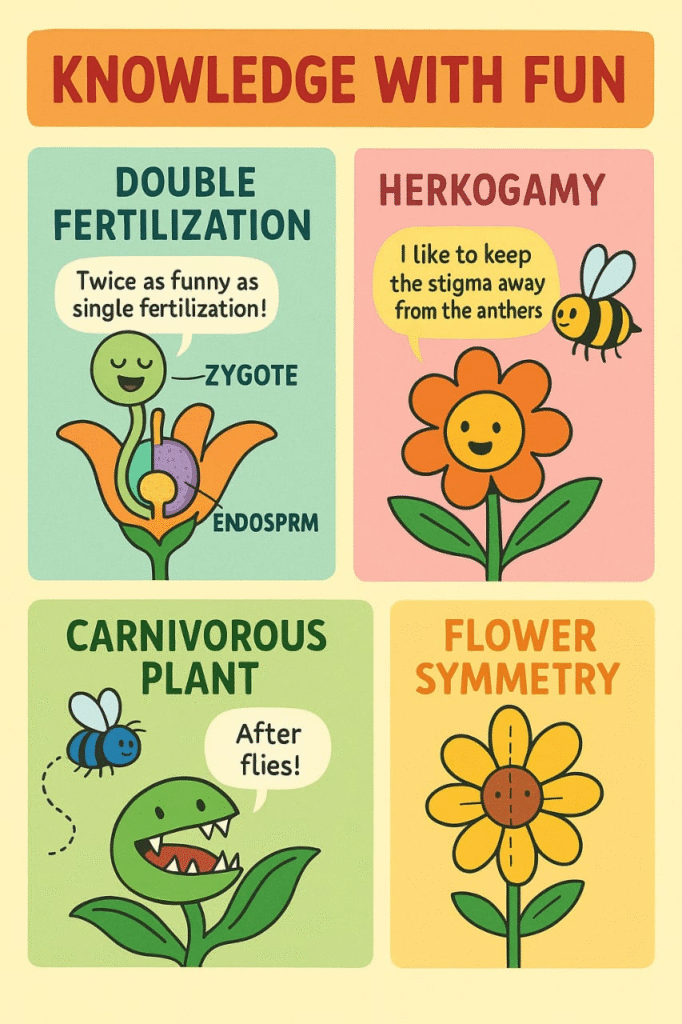
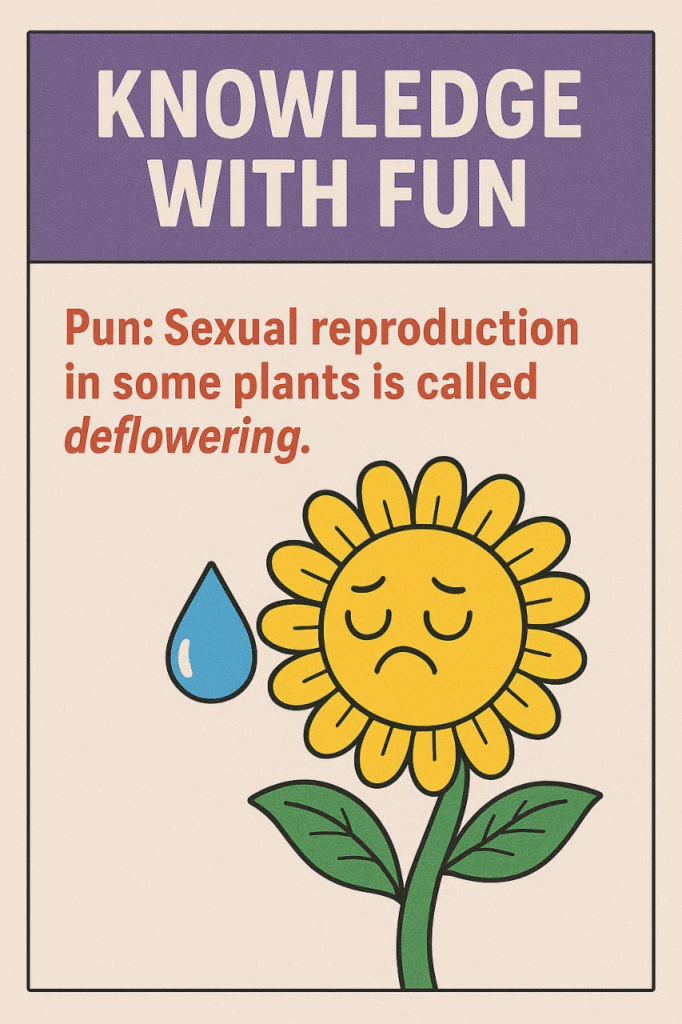
————————————————————————————————————————————————————————————————————————————
MNEMONICS
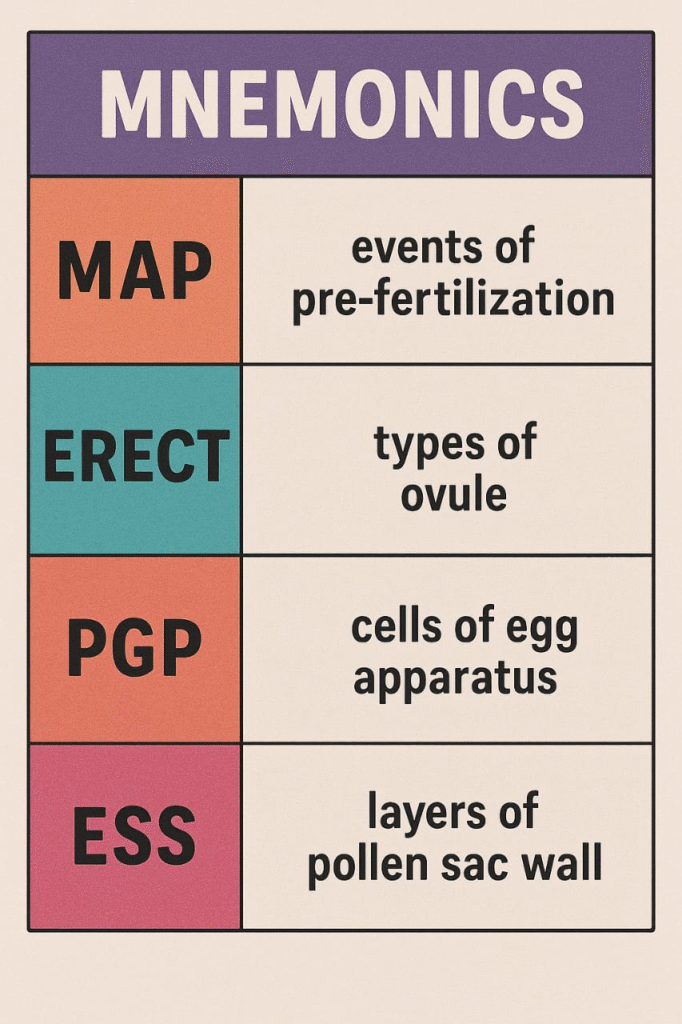
————————————————————————————————————————————————————————————————————————————
MIND MAP
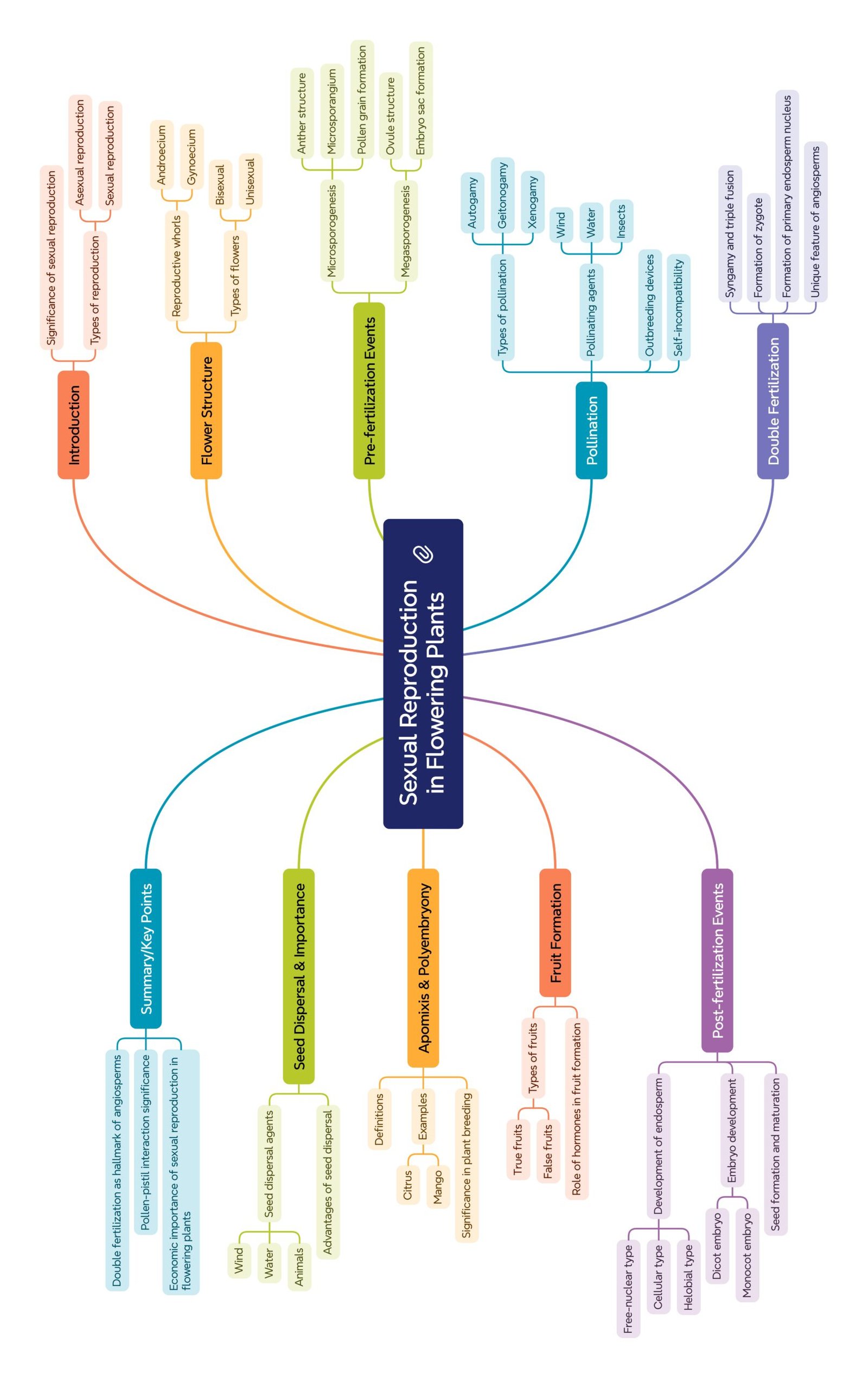
——————————————————————————————————————————————————————————————————————————————————————
